 W
WAuschwitz and After is a first person account of life and survival in Birkenau by Charlotte Delbo, translated into English by Rose C. Lamont.
 W
WAuschwitz Report (2006) is a non-fiction report on the Auschwitz extermination camp by Primo Levi and Leonardo de Benedetti.
 W
WBehind Enemy Lines is a 2002 autobiographical book co-written by Holocaust survivor Marthe Cohn and Wendy Holden. It details Cohn's exploits as a French Jew during the Holocaust and World War II when, working as a nurse, she traveled into German territory to collect intelligence for the French Army, as the Allied forces started making advances on Germany, pushing the German forces back during World War II
 W
WThe Black Hole of Auschwitz is a collection of essays by the Italian author Primo Levi. Originally published under the Italian title Asymmetry and Life it has two distinct halves. The first half, The Black Hole of Auschwitz is a collection of essays, often prefaces to other books, which make a plea against Holocaust denial. The second half, Other People's Trades, is a mixture of essays on a wide variety of subjects. All of these works were collected together in the production of the Italian anthology of Levi's works, Opere, in 1997.
 W
WA Boy Named 68818 is a true-life account of Israel "Srulik" Stark in the Holocaust, his spiritual resistance, and rebuilding afterwards, written by his daughter, Miriam (Stark) Miller. Aimed for children aged 10–14 as well as adults, the book was published in 2015 and distributed by Feldheim Publishers. It was praised by several Jewish and Holocaust memorial organizations.
 W
WClara's War: One Girl's Story of Survival is a 2009 memoir by Clara Kramer and Stephen Glantz which tells Kramer's story of her life in Nazi occupied Poland, where she and several other Polish Jews spent 20 months hiding in a bunker beneath a house in the town of Zhovkva. The book was first published in the United States by Harper/Ecco on April 21, 2009. Kramer is a founder of the Holocaust Resource Center at Kean University in Union, New Jersey.
 W
WCollected Poems is the English language collection of poems by Italian author Primo Levi. Its Italian title is Ad ora incerta.
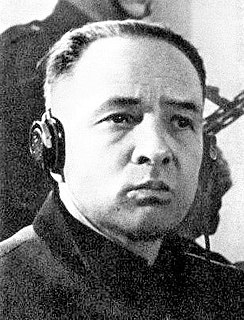 W
WRudolf Franz Ferdinand Höss was a German SS officer during the Nazi era who, after the defeat of Nazi Germany, was convicted for war crimes. Höss was the longest-serving commandant of Auschwitz concentration and extermination camp. He tested and implemented means to accelerate Hitler's order to systematically exterminate the Jewish population of Nazi-occupied Europe, known as the Final Solution. On the initiative of one of his subordinates, Karl Fritzsch, Höss introduced the pesticide Zyklon B to be used in gas chambers, where more than a million people were killed.
 W
WThe Defiant: A True Story of Jewish Vengeance and Survival is a World War II memoir by Shalom Yoran, a Holocaust survivor and a former Jewish partisan. It was written in the late 1940s, shortly after the war, but only published in 1996 after the author rediscovered his manuscript and dictated it in Hebrew for translation into English.
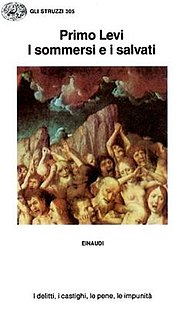 W
WThe Drowned and the Saved is a book of essays by Italian-Jewish author and Holocaust survivor Primo Levi on life and death in the Nazi extermination camps, drawing on his personal experience as a survivor of Auschwitz (Monowitz). The author's last work, written in 1986, a year before his death, The Drowned and the Saved is an attempt at an analytical approach, in contrast to his earlier books If This Is a Man (1947) and The Truce (1963), which are autobiographical.
 W
WFive Chimneys, originally published 1946 in French as Souvenirs de l'au-delà, is the memoir of Olga Lengyel about her time as a prisoner in the Nazi concentration camp Auschwitz.
 W
WForgotten Voices of the Holocaust is a collection of interviews with victims of the Holocaust as well as people who collaborated with or worked directly for the Nazi regime. The Imperial War Museum commissioned Lyn Smith to work with them on their sound archive. The interviews she brought together are now part of their permanent Holocaust exhibit as well as being set down in this book from Ebury Press.
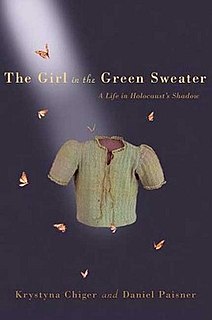 W
WThe Girl in the Green Sweater: A Life in Holocaust’s Shadow, written by coauthors Krystyna Chiger and Daniel Paisner, was published by St. Martin’s Press in 2008.
 W
WHere My Home Once Stood: A Holocaust Memoir (ISBN 0-615-21703-6) is a 2008 World War II memoir told in Russian by Moyshe Rekhtman and transcribed, translated and written by his grandson Phil Shpilberg.
 W
WThe Hiding Place is a 1971 book on the life of Corrie ten Boom, written by herself and John and Elizabeth Sherrill.
 W
WHolocaust and Memory, originally published in 1996 in Polish and translated into English in 2001, is a book by Barbara Engelking and edited by Gunnar S. Paulsson. Engelking analyzes a series of Jewish survivors living in Poland to explore how their life under the Nazis impacted them. It was published in English by Leicester University Press.
 W
WI Never Saw Another Butterfly: Children's Drawings and Poems from Terezin Concentration Camp, 1942–1944 is a collection of works of art and poetry by Jewish children who lived in the concentration camp Theresienstadt. They were created at the camp in secret art classes taught by Austrian artist and educator Friedl Dicker-Brandeis. The book takes its title from a poem by Pavel Friedmann, a young man born in 1921 who was incarcerated at Theresienstadt and was later killed at Auschwitz. The works were compiled after World War II by Czech art historian Hana Volavková, the only curator of the Jewish Museum in Prague to survive the Holocaust. Where known, the fate of each young author is listed. Most died prior to the camp being liberated.
 W
WIf This Is a Man is a memoir by Italian Jewish writer Primo Levi, first published in 1947. It describes his arrest as a member of the Italian anti-fascist resistance during the Second World War, and his incarceration in the Auschwitz concentration camp (Monowitz) from February 1944 until the camp was liberated on 27 January 1945.
 W
WIn Search of My Father: The Journey of a Child Holocaust Survivor is a 2010 book by a Holocaust survivor Paul Drexler. The book chronicles the author's research about his father's death during a British bombardment days before German capitulation.
 W
WKaiserhofstraße 12 is a memoir by the German author Valentin Senger (1918–1997), who was born in Frankfurt to Russian-born Jewish parents. Originally published in German in 1978, it depicts his childhood at Kaiserhofstraße in central Frankfurt during the Weimar Republic and the Nazi era, and how his Jewish family survived the entire Nazi era undetected in the middle of Frankfurt with the help of several non-Jewish friends and neighbours at Kaiserhofstraße, sympathetic public officials, his mother's creativity and a good portion of luck. Senger was 14 years old when the Nazis came to power.
 W
WLeap into Darkness is a 1998 memoir by Holocaust survivor Leo Bretholz and co-author Michael Olesker, in the vein of Night by Elie Wiesel or My Brother's Voice (2003) by Stephen Nasser, in which he recounts the astounding story of his surviving the Holocaust as a young man owing to his wits, stomach for risk taking and well developed flight instinct.
 W
WThe Lost: A Search for Six of Six Million (ISBN 978-0-06-054297-9) is a non-fiction memoir by Daniel Mendelsohn, published in September 2006, which has received critical acclaim as a new perspective on Holocaust remembrance. It was awarded the National Book Critics Circle Award, the National Jewish Book Award, and the Prix Médicis in France. It was shortlisted for the Duff Cooper History Prize in the UK. An international bestseller, The Lost has been translated into numerous languages, including French, German, Dutch, Italian, Spanish, Portuguese, Greek, German, Romanian, Turkish, Norwegian, and Hebrew.
 W
WThe Man Who Broke Into Auschwitz is the title of an autobiographical book by Denis Avey, who is a recipient of a British Hero of the Holocaust award. The book was written together with Rob Broomby and published by Hodder in 2011. It carries a foreword by Sir Martin Gilbert. The novelist James Long assisted with research and helped to edit and structure the manuscript.
 W
WMan's Search for Meaning is a 1946 book by Viktor Frankl chronicling his experiences as a prisoner in Nazi concentration camps during World War II, and describing his psychotherapeutic method, which involved identifying a purpose in life to feel positive about, and then immersively imagining that outcome. According to Frankl, the way a prisoner imagined the future affected his longevity. The book intends to answer the question "How was everyday life in a concentration camp reflected in the mind of the average prisoner?" Part One constitutes Frankl's analysis of his experiences in the concentration camps, while Part Two introduces his ideas of meaning and his theory called logotherapy.
 W
WMichelangelo in Ravensbrück: One Woman's War against the Nazis is a memoir by Karolina Lanckorońska, a World War II resistance fighter and postwar historian who survived the Ravensbrück concentration camp for women and after liberation went on to record the history of this lesser known side of the Holocaust in occupied Poland. Initially, Lanckorońska did not want her war memoir published in her lifetime. However, after much persuasion she consented to publication in Poland, by ZNAK Publishing of Kraków in 2001, a year before her death. The book, whose British version is titled Those Who Trespass against Us: One Woman's War against the Nazis, sold over 50,000 copies in the Polish original and is now selling well in English. The U.S. edition was published in hardback in Spring 2007 by Da Capo Press under the new title, Michelangelo in Ravensbrück.
 W
WMy Opposition is a diary secretly written by the German social democrat Friedrich Kellner (1885–1970) during World War II to describe life under Nazi Germany and to expose the propaganda and the crimes of the Nazi dictatorship. Comprising ten notebooks, it is considered by leading historians as "an important piece of historical literature." The editors of the German magazine Der Spiegel called it "an image of Nazi Germany that has never existed before in such a vivid, concise and challenging form." Kellner began his 861-page diary on September 1, 1939, and wrote his last entry on May 17, 1945. In 1968 he gave the diary to his American grandson, Robert Scott Kellner, to translate into English and to bring it to the attention of the public.
 W
WNight is a 1960 book by Elie Wiesel based on his Holocaust experiences with his father in the Nazi German concentration camps at Auschwitz and Buchenwald in 1944–1945, toward the end of the Second World War in Europe. In just over 100 pages of sparse and fragmented narrative, Wiesel writes about the death of God and his own increasing disgust with humanity, reflected in the inversion of the parent–child relationship as his father deteriorates to a helpless state and Wiesel becomes his resentful, teenage caregiver. "If only I could get rid of this dead weight ... Immediately I felt ashamed of myself, ashamed forever." In Night everything is inverted, every value destroyed. "Here there are no fathers, no brothers, no friends", a kapo tells him. "Everyone lives and dies for himself alone."
 W
WIser Lubotzky (Lubocki) was a member of Betar, the Vilna-ghetto's underground and a partisan fighter. He was both a fighting member and a commander of the Irgun, serving as a national recruiting officer and heading the Ramat Gan group. As a lawyer, he served as the head of Herut’s lawcourt and as the Likud's first legal adviser.
 W
WThe Oath is a novel by Elie Wiesel. It tells the story of Azriel, the only surviving Jewish member of the small Hungarian town of Kolvillàg after a pogrom perpetrated by neighboring Christians. Azriel carries the secret of Kolvillàg's destruction within him, forbidden to share his experiences. However, when Azriel meets a young man on the brink of suicide fifty years later, he realizes that he must pass on his secret to save the young man's life - yet he is bound by his promise to the dead.
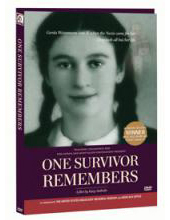 W
WOne Survivor Remembers is a 1995 documentary short film by Kary Antholis.
 W
WThe Pianist is a memoir by the Polish-Jewish pianist and composer Władysław Szpilman in which he describes his life in Warsaw in occupied Poland during World War II. After being forced with his family to live in the Warsaw Ghetto, Szpilman manages to avoid deportation to the Treblinka extermination camp, and from his hiding places around the city witnesses the Warsaw Ghetto Uprising in 1943 and the Warsaw Uprising the following year. He survives in the ruined city with the help of friends and strangers, including Wilm Hosenfeld, a German army captain who admires his piano playing.
 W
WStill Alive (2001) written by Ruth Klüger, is a memoir of her experiences growing up in Nazi-occupied Vienna and later in the concentration camps of Theresienstadt, Auschwitz-Birkenau, and Christianstadt. However, as it's written by Klüger as a 70-year-old woman, the memoir goes beyond her experience as an inmate, chronicling her escape from Christianstadt's death march with her mother and adopted sister, Susi. The narrative ends not only with their self-liberation, or even with the general liberation by Allied forces, but goes beyond to her life as a post-war refugee. She outlines for the reader the difficulties she experienced in migrating to America, as well as the challenges and culture shock she faced as a foreigner trying to obtain an education and a place in society.
 W
WThe Sunflower: On the Possibilities and Limits of Forgiveness is a book on the Holocaust by Holocaust survivor Simon Wiesenthal, in which he recounts his experience with a mortally wounded Nazi during World War II. The book describes Wiesenthal's experience in the Lemberg concentration camp and discusses the moral ethics of the decisions he made. The title comes from Wiesenthal's observation of a German military cemetery, where he saw a sunflower on each grave, and fearing his own placement in an unmarked mass grave. The book's second half is a symposium of answers from various people, including other Holocaust survivors, religious leaders and former Nazis. The book was originally published in German by Opera Mundi in Paris, France in 1969. The first English translation was published in 1970.
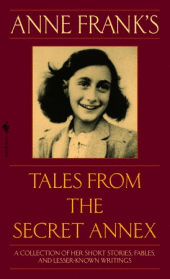 W
WTales from the Secret Annex is a collection of miscellaneous prose fiction and non-fiction written by Anne Frank while she was in hiding during the Nazi occupation of The Netherlands. It was first published in The Netherlands in 1949, then in an expanded edition in 1960. A complete edition appeared in 1982, and was later included in the 2003 publication of The Revised Critical Edition of The Diary of Anne Frank.
 W
WTell Me Another Morning is an autobiographical novel by Zdena Berger, a survivor of Holocaust camps at Theresienstadt, Auschwitz and Bergen-Belsen. Berger began writing the book in 1955 after coming to North America and in 1961 she published the work through Harper & Brothers. The work went out of print shortly thereafter but was reissued in 2007 through Paris Press. The book depicts the experiences of Tania Andersova, a teenage girl who is taken away to the Nazi concentration camps during the Holocaust.
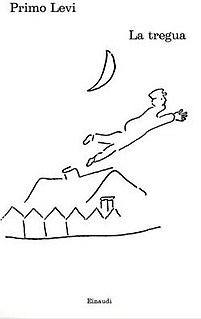 W
WThe Truce, titled The Reawakening in the US, is a book by the Italian author Primo Levi. It is the sequel to If This Is a Man and describes the author's experiences from the liberation of Auschwitz (Monowitz), which was a concentration camp, until he reaches home in Turin, Italy, after a long journey. He describes the situation in different displaced persons camps after the Second World War.
 W
WTwilight, originally published in 1988 in French as Le crépuscule, au loin, is a novel by Elie Wiesel. Twilight is the fictional story of a Holocaust survivor named Raphael Lipkin who is now a psychologist living in the United States of America. He visits a psychiatric ward called "The Mountain Clinic," where he interviews several psychiatric patients who believe themselves to be various characters from the Old Testament. Interwoven with these accounts are Raphael's own memories of his life before and during the Holocaust.
 W
WThe Upstairs Room is a 1972 Holocaust survivor autobiography by Johanna Reiss documenting her childhood in occupied Holland during the Nazi invasion.
 W
WBeni Virtzberg was an Israeli forester, Holocaust survivor and writer who was among the first in Israel to write an autobiographical account of his experiences during and after the Holocaust. He began writing his book Migei Haharega Lesha'ar Hagai in the wake of the Adolf Eichmann trial, when court testimony by survivors prompted Israelis to openly and publicly discuss what the survivors had lived through.
 W
WWitness: Passing the Torch of Holocaust Memory to New Generations is a large format volume, published by Canadian Second Story Press, inspired by a 2014 United Nations exhibit of reflections and images of Holocaust survivors and students who have traveled on the March of the Living since 1988. The exhibit and the book are intended to educate a new generation of students about the atrocities of the Second World War. In collaboration with March of the Living, an organization that spearheads visits to the Polish grounds where Nazi atrocities occurred, Toronto religious leader and Holocaust educator Eli Rubenstein compiled this book which includes an introduction from Pope Francis.
 W
WYellow Star is a 2006 biographical children's novel by Jennifer Roy. Written in free verse, it depicts life through the eyes of a young Jewish girl whose family was forced into the Łódź Ghetto in 1939 during World War II. Roy tells the story of her aunt Syvia, who shared her childhood memories with Roy more than 50 years after the ghetto's liberation. Roy added fictionalized dialogue, but did not otherwise alter the story. The book covers Syvia's life as she grows from four and a half to ten years old in the ghetto. Syvia, her older sister Dora, and her younger cousin Isaac were three of only twelve children who survived. After the war, Syvia moved to the United States, married, and only much later told her story to Roy. Since its publication in 2006, the book has received multiple awards, starred reviews, and other accolades, and has been made into a likewise well-received audiobook.
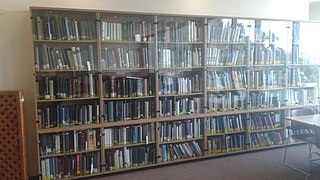 W
WYizkor books are memorial books commemorating a Jewish community destroyed during the Holocaust. The books are published by former residents or landsmanshaft societies as remembrances of homes, people and ways of life lost during World War II. Yizkor books usually focus on a town but may include sections on neighboring smaller communities.